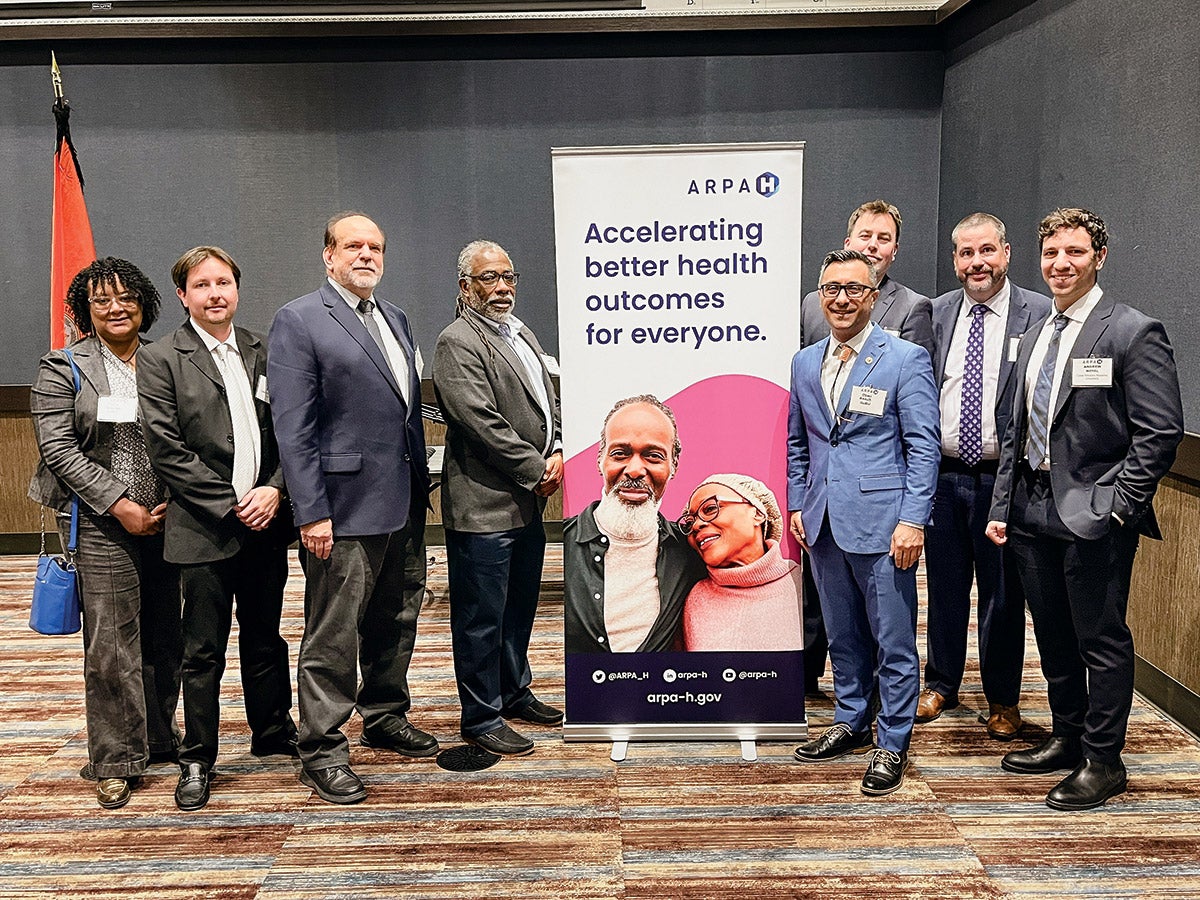lens
Joint Effort
CWRU-led team developing a replacement knee that fully heals and feels human
 Local members of the joint-replacement project include, from left: Taña Spencer, Rodrigo Somoza Palacios, Jean Welter, David Miller, Ozan Akkus, Daniel Pendergast, Daniel Savage and Andrew Moyal. All of them work at CWRU, except Moyal, who is at University Hospitals.
Local members of the joint-replacement project include, from left: Taña Spencer, Rodrigo Somoza Palacios, Jean Welter, David Miller, Ozan Akkus, Daniel Pendergast, Daniel Savage and Andrew Moyal. All of them work at CWRU, except Moyal, who is at University Hospitals.More than 32 million people in the United States suffer from the degenerative joint disease known as osteoarthritis, and about 1.3 million have knee or hip-replacement surgery annually—exchanging real bone and tissue for metal, plastic or ceramic substitutes.
But a federal contract of up to $47.7 million awarded to a Case Western Reserve University-led multi-center consortium* is advancing research on what could be a life-changing option: replacement joints grown from human cells that would heal and regenerate like other living tissue.
"This will feel more like a 'real knee' compared to metal or polymer implants," said Ozan Akkus, PhD (GRS '00, mechanical engineering), who leads the research and is the Kent H. Smith Professor of Engineering and director of the Tissue Fabrication and Mechanobiology Lab on campus.
The contract with the Advanced Research Projects Agency for Health (ARPA-H) Novel Innovations for Tissue Regeneration in Osteoarthritis (NITRO) program has two parts: $20.4 million in the first phase, and, if certain milestones are met, $27.3 million in phase two. ARPA-H is an agency within the U.S. Department of Health and Human Services.
The goal is to treat 40 patients with the new joints within five years—and eventually have the technology commercially produced and broadly available.
"The backbone" of the implant "is a synthetic scaffold that will be populated with live human cells," said Jean Welter, MD, PhD (GRS '96, physiology), a CWRU research associate professor in biology, who specializes in tissue engineering and regeneration, and is director of the Center for Modular Manufacturing of Structural Tissue on campus.
The new knee would likely be ready in a matter of weeks. Once implanted, the synthetic material would gradually be replaced by bone and cartilage the body regrows.
Because human tissue molecules regularly turn over, with new ones taking the place of those that have worn out, the replacement joint could be maintained for a lifetime. In comparison, metal or plastic joints can wear out after about 20 years and don't stand up to high-impact activities, such as running, soccer or skiing.
"This is our chance to really do something that has potentially a huge impact in healthcare," said Harihara Baskaran, PhD, the Leonard Case Jr. Professor of Engineering and chair of the Department of Chemical and Biomolecular Engineering.
Baskaran's lab includes the bioreactors where living human cells merge with the synthetic scaffolds and mature into tissues.
Osteoarthritis, which affects an estimated 500 million people globally, happens when the cushiony cartilage that keeps joints moving smoothly breaks down and turns rough. In extreme cases, it wears away completely. Joints become stiff, swollen and painful.
Moreover, if osteoarthritis is left untreated, the pain can lead to social isolation, loneliness and self-medication. Black patients may experience a disproportionate share of that suffering because of discrimination and provider misconceptions that can lead to inadequate pain management, said David B. Miller, PhD, an associate professor at the university's Jack, Joseph and Morton Mandel School of Applied Social Sciences, who serves as the equity officer on the project.
Miller is reaching out to patients from Black, Hispanic, Native American and Alaskan native communities to make sure that "the voices of marginalized populations are heard throughout the process of this research endeavor."
The project builds on and continues CWRU's reputation as a longtime, interdisciplinary leader in knee-implant surgery and tissue engineering. "And that gives us goosebumps whenever we think about it," Akkus said.
*The research team also includes University Hospitals of Cleveland, Colorado State University, Massachusetts General Hospital, The Ohio State University, Rice University, Sapphiros AI Bio, Washington State University, and Louis Stokes Cleveland Veterans Affairs Medical Center.
— KATE BECKER





